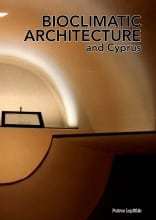“Bioclimatic Architecture and Cyprus”, by Petros Lapithis, sets out to demonstrate that bioclimatic architecture is a viable energy-saving concept which can be applied in the context of Cyprus through both research and hands-on examples. A principal aim of the research revealed in this publication was to develop an understanding of the criteria needed for an appropriate bioclimatic architecture that is sensitive to both energy use and climatic conditions.
For this purpose, the climatic conditions Cyprus, thermal comfort, passive solar systems, comparison of vernacular and contemporary buildings, energy uses, building and energy legislation, education in bioclimatic architecture and building examples (academic and professional) were studied, concluding that passive solar design may be successfully applied through the design of modern buildings in Cyprus.
A crucial argument that transpires from this research is whether environmentally responsible architecture should be regarded as a specialisation within architectural education or whether the entire spectrum of architecture should be taught as a science and as an art that is equally accountable to man and to the environment. This begs the question: Shouldn’t architecture always be ecologically responsible?
This book brings local case studies to the forefront in an attempt to give a concrete understanding of bioclimatic architecture. It entails of a compilation of student design projects from the Department of Architecture of the University of Nicosia as well as built projects by the author which address bioclimatic design approaches.
The goal of this book is to transcend knowledge without any monetary benefit. The book is available for free.
View low-resolution book
Download high-resolution print
Order the high resolution printed book here


